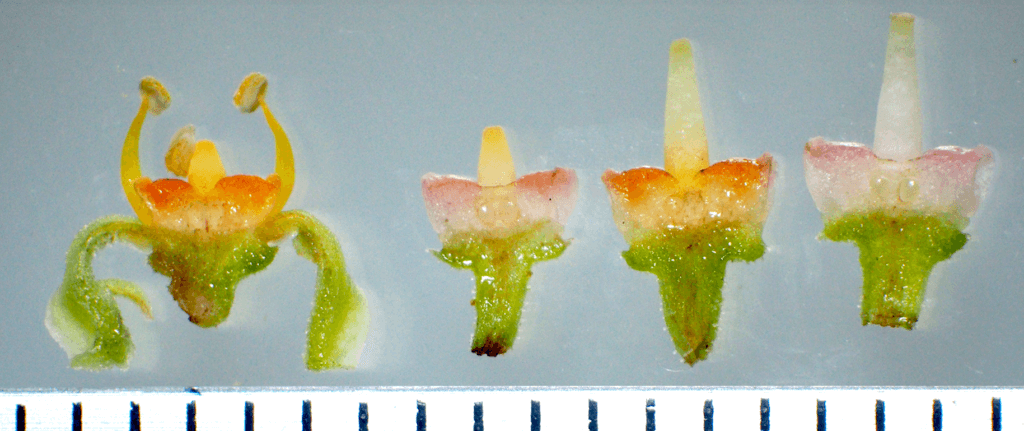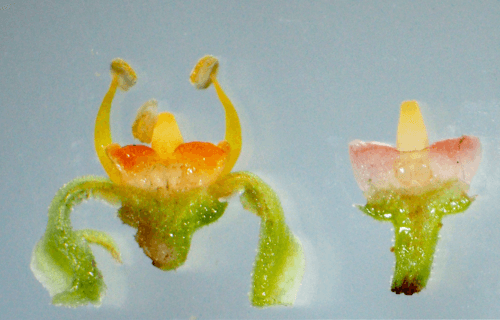TOKYO, Japan — A spectacular flower that changes colors during its life cycle — and can change back again! — may hold the key to feeding the world, according to new research.
Causonis japonica can go from orange to bright pink and back again, making it the only known plant that returns to its original hue, according to researchers from the University of Tokyo. The Japanese species relies on a pigment called carotenoid, found in nutrient-rich fruit and vegetables such as carrots. The discovery could end up boosting crop yields, study authors say.
The global population will reach nearly 10 billion within the next three decades. Each degree of warming reduces crops by up to a quarter. Prolonged droughts or floods exacerbate the problem. To counter that, agricultural productivity must double in the next 30 years to meet demands, according to estimates.
“Even though I’ve studied this plant in detail, having discovered there were at least two varieties back in 2000, the bidirectional color-changing flowers were a completely unexpected finding,” says lead author Professor Hirokazu Tsukaya from the University of Tokyo in a media release.
The color-switching flowers show the most rapid accumulation of carotenoid ever seen. Carrots are orange thanks to it. The chemical is a good source of vitamin A. C. japonica opens the door to developing carotenoid-containing vegetables that mature faster or contain higher amounts of nutrients.
“Our next steps will be to find out what is governing the behaviors we have observed,” Tsukaya adds.

C. japonica may be one of a kind
Hundreds of flowers change color to improve visibility, boosting pollination. It shows nectar is available to insects. However, it’s always unidirectional, meaning the color never goes back to the way it was. This is what makes C. japonica exceptional.
“My colleague Professor Nobumitsu Kawakubo from Gifu University is an expert in time-lapse, long-period video recordings of pollinating flowers. He and his student originally tried to explore the pollinating behaviors between the different kinds of Causonis japonica and expected to see the familiar change from its default orange color to bright pink,” Tsukaya continues.
“But they couldn’t believe it when they reviewed the time-lapse video and saw that it not only changed back to orange again, but that this change oscillated between the two states. They informed me on this finding; this compelled us to find out why. So we started a collaboration.”
Scientists got to the bottom of the phenomenon by combining carefully captured time-lapse videos from the field with detailed observations in the lab.
“The initial orange state is coincident with the male stage of the flower’s maturation, when it is secreting nectar,” the study author explains. “When the stamen — male part — becomes old and detaches, the flowers turn pink. Mere hours later, the pistil — female part — begins to mature, secretes nectar, and the flower turns orange again. Once that stage is over, the flower fades to pink. The main chemical responsible for the color changing is orange-yellow carotenoid; its cycle of accumulation and degradation is also the fastest known to date. That fact was another surprise to us.”
What do people use the flower for?
C. japonica is native to Asia, Australia, and the West Pacific. It is used as a traditional Chinese medicine to relieve swelling.
“One big question we have is, at what level are the stages of the cycles regulated? Is it caused by proteins caught in a feedback cycle, or does something occur on a genetic level? We will continue to explore this and hope to find an explanation soon,” Tsukaya concludes.
“It’s strange to think that several hundred years ago, agriculturalists in Japan hated Causonis japonica because of its vigorous nature. But a novelist, Kyoka Izumi, wrote about them so favorably, I wonder if it helped maintain some interest in preserving them. Whatever the reason, I’m glad they are around now to share their secrets with us. I wonder what we’ll discover next.”
The study is published in Scientific Reports.
South West News Service writer Mark Waghorn contributed to this report.


Warming doesn’t reduce crops, it increases them. This article is pure hogwash.🤮
Hilariously misleading.
David P made my point. “Each degree of warming reduces crops by up to a quarter” is the most incredibly stupid thing written in seriousness that I’ve ever seen. Not even a drunk Gretta would write this.